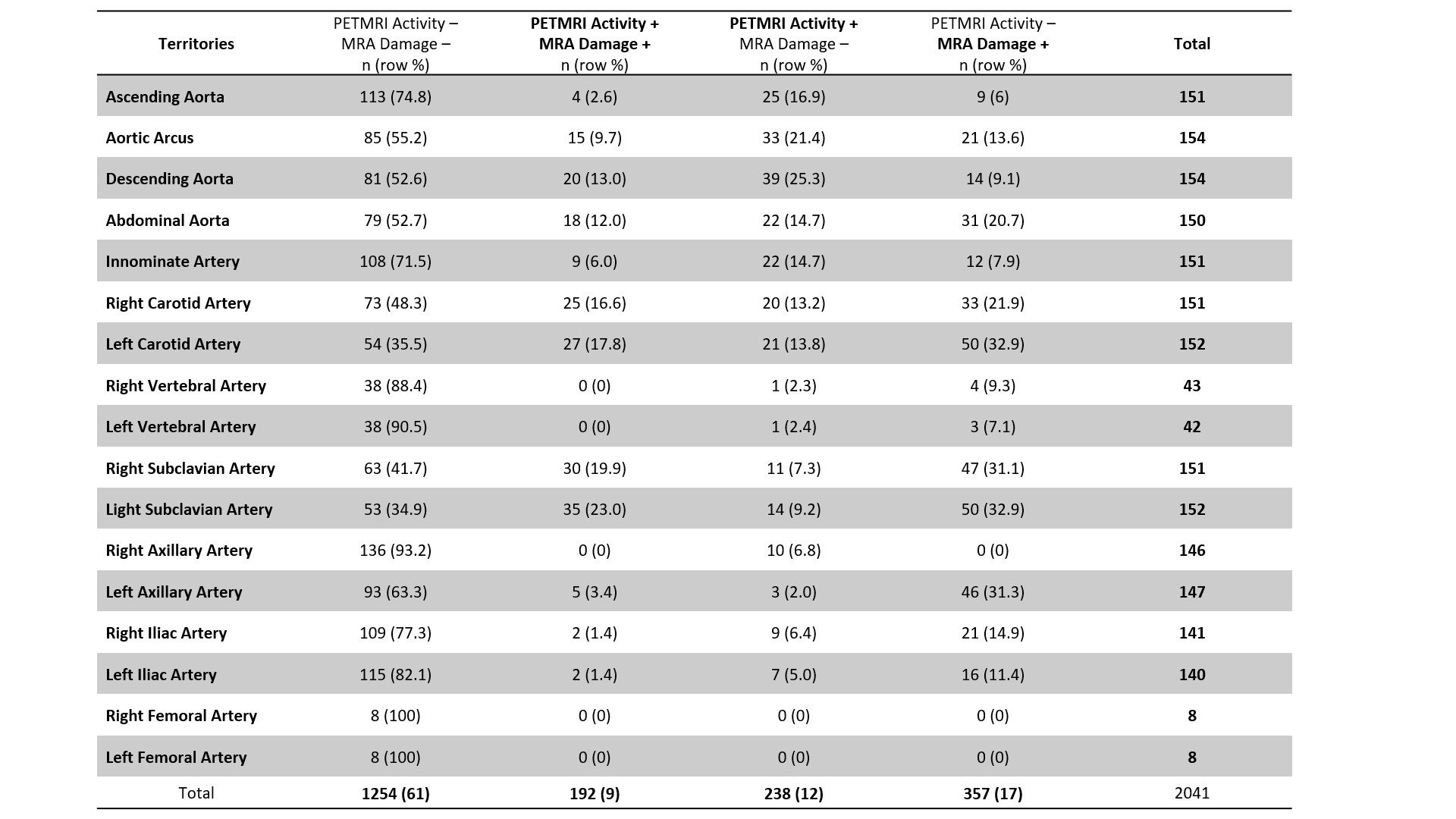Session Information
Date: Tuesday, November 9, 2021
Title: Vasculitis – Non-ANCA-Associated & Related Disorders Poster II (1862–1888)
Session Type: Poster Session D
Session Time: 8:30AM-10:30AM
Background/Purpose: Imaging modalities play an important role in the diagnosis and management of patients with large-vessel vasculitis (LVV). Use of 18F-fluorodeoxyglucose (FDG) positron emission tomography – computed tomography (PET/CT) to assess patients with LVV is well established; however, concerns about ionizing radiation exposure may limit its use, particularly in younger populations. PET coupled with magnetic resonance imaging (PET/MRI) offers potential for simultaneous acquisition of PET and angiography at substantially less radiation exposure than PET/CT. We aimed to investigate whether PET/MRI is a useful surrogate to PET/CT in LVV.
Methods: Participants who fulfilled the 1990 ACR Classification Criteria for Takayasu’s arteritis (TAK) or modified 1990 ACR Criteria for giant cell arteritis (GCA), were prospectively recruited into an observational cohort. Following injection of one radiotracer dose, patients underwent a whole body PET/MR at 1-hour acquisition time and, whenever possible, a PET/CT at 2-hour acquisition time. A single reader with vascular imaging expertise interpreted FDG uptake relative to liver uptake by visual assessment (scale 0-3) in 9 arterial territories. The PET Vascular Activity Score (PETVAS) was calculated for each study (scale 0-27)). MR angiography was obtained concurrently with the PET/MR study. Angiographic damage, defined as stenosis, occlusion, or aneurysm, was evaluated in 4 segments of the aorta and 13 branch arteries and compared to PET findings in the same territories. Patients could be studied repeatedly at ≥ 6-month intervals.
Results: PET/MR was obtained in 203 scans from 76 LVV patients (TAK: 93 scans in 36 patients and GCA: 110 scans in 40 patients). Eighteen scans were performed in 9 pediatric patients (< 18 years old). For 178 visits (87.8%), simultaneous PET/CT scans were obtained on the same day. PET/MRI-based PETVAS scores correlated with PET/CT based scores for both TAK and GCA (Spearman’s correlation coefficient (r)= 0.59, CI95%: 0.48-0.67, p< 0.001; Figure-1). PET/CT scores were consistently higher than PET/MR scores (Median:19 and IQR: 8 vs Median:16 and IQR: 10.25) likely due to effects of delayed imaging acquisition (1 versus 2-hour uptake time). Out of 2041 arterial territories from 154 scans with both MRI angiography (MRA) and PET/MRI data; PET and MRA showed concordant abnormalities in 1446 territories (71%) and discordant finding in 595 territories (29%). No PET activity or damage was seen in 1254 territories (61%). PET activity with damage was seen in 192 territories (9%). PET activity without damage was seen in 238 territories (12%). Damage without PET activity was seen in 357 territories (17%). (Table-1 and Figure-2).
Conclusion: PET/MRI findings correlate with PET/CT findings in LVV. PET provides complimentary data to MRA that may better inform a clinician about vascular inflammation and damage. Given the need to minimize ionizing radiation exposure in younger patients who will potentially undergo serial imaging studies, PET/MRI is a safe and reliable alternative to PET/CT in patients with LVV.
 Figure_1. Distribution of PET/MRI-based and PET/CT-based PETVAS in patients with Takayasu’s arteritis and giant cell arteritis
Figure_1. Distribution of PET/MRI-based and PET/CT-based PETVAS in patients with Takayasu’s arteritis and giant cell arteritis
 Table_1. Vascular damage by MRA and metabolic activity by PET/MRI according to different vascular territories
Table_1. Vascular damage by MRA and metabolic activity by PET/MRI according to different vascular territories
 Figure_2. Percentage distribution of vascular damage by MRA and metabolic activity by PET/MRI according to different vascular territories
Figure_2. Percentage distribution of vascular damage by MRA and metabolic activity by PET/MRI according to different vascular territories
To cite this abstract in AMA style:
bolek E, Quinn K, Alessi H, Novakovich E, Ahlman M, Grayson P. 18F-Fluorodeoxyglucose PET/MRI as an Alternative Hybrid Imaging Modality: Comparative Study in a Prospective, Longitudinal Cohort of Patients with Large-Vessel Vasculitis [abstract]. Arthritis Rheumatol. 2021; 73 (suppl 9). https://acrabstracts.org/abstract/18f-fluorodeoxyglucose-pet-mri-as-an-alternative-hybrid-imaging-modality-comparative-study-in-a-prospective-longitudinal-cohort-of-patients-with-large-vessel-vasculitis/. Accessed .« Back to ACR Convergence 2021
ACR Meeting Abstracts - https://acrabstracts.org/abstract/18f-fluorodeoxyglucose-pet-mri-as-an-alternative-hybrid-imaging-modality-comparative-study-in-a-prospective-longitudinal-cohort-of-patients-with-large-vessel-vasculitis/
